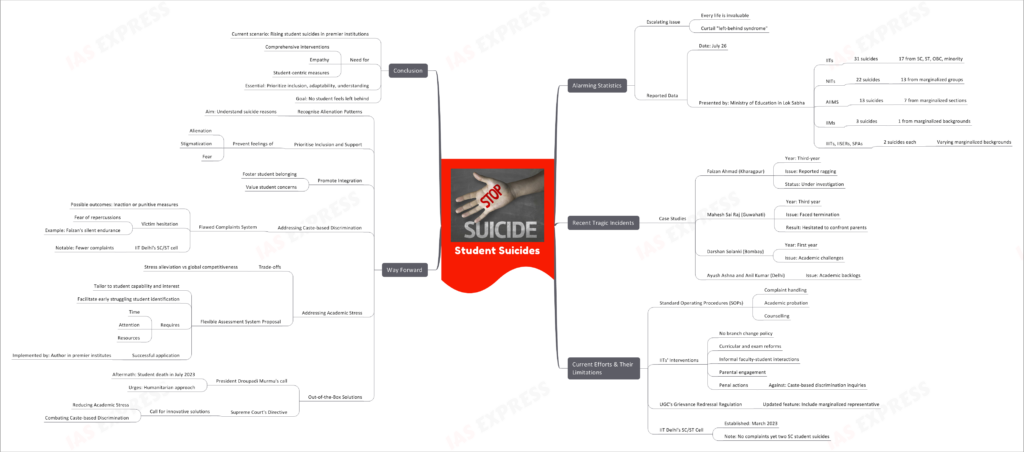Student Suicides- How can we solve it?
From Current Affairs Notes for UPSC » Editorials & In-depths » This topic
IAS EXPRESS Vs UPSC Prelims 2024: 80+ questions reflected
The escalating issue of student suicides in India’s premier institutions necessitates immediate and effective interventions. As these incidents continue to rise, the core message remains clear: every life is invaluable, and the “left-behind syndrome” needs to be curtailed.

Alarming Statistics
- Reported Data: Ministry of Education presented alarming statistics on student suicides in the Lok Sabha on July 26.
- IITs: 31 suicides (17 from SC, ST, OBC, and minority communities)
- NITs: 22 suicides (13 from marginalized groups)
- AIIMS: 13 suicides (7 from marginalized sections)
- IIMs: 3 suicides (1 from marginalized backgrounds)
- IIITs, IISERs, SPAs: 2 suicides each (varying numbers from marginalized backgrounds)
Recent Tragic Incidents
- Case Studies:
- Faizan Ahmad (Kharagpur): Third-year student; reported ragging, currently under investigation.
- Mahesh Sai Raj (Guwahati): Faced termination in his third year; hesitated to confront parents.
- Darshan Solanki (Bombay): Encountered academic challenges in his first year.
- Ayush Ashna and Anil Kumar (Delhi): Suffered from academic backlogs.
Current Efforts & Their Limitations
- Standard Operating Procedures (SOPs): Even with the presence of complaint handling, academic probation, and counselling, suicides continue to indicate insufficiencies in these systems.
- IITs’ Interventions:
- No branch change policy
- Curricular and exam reforms
- Informal faculty-student interactions
- Parental engagement initiatives
- Penal actions for caste-based discrimination inquiries
- UGC’s Grievance Redressal Regulation: Updated to include a representative from a marginalized background.
- IIT Delhi’s SC/ST Cell: Established in March 2023, but despite no registered complaints, two SC students ended their lives.
Out-of-the-Box Solutions
- President’s Call: President Droupadi Murmu urges a humanitarian approach following the death of a student in July 2023.
- Supreme Court’s Directive: Calls for innovative solutions to tackle the persistent issue, emphasizing:
- Reducing Academic Stress
- Combating Caste-based Discrimination
Addressing Academic Stress
- Trade-offs: Balancing stress alleviation and maintaining global competitiveness.
- Flexible Assessment System Proposal:
- Tailor assessment according to student’s capability and interest.
- Facilitate early identification of struggling students.
- Requires investment in terms of time, attention, and resources.
- Successful application by the author in premier institutes.
Addressing Caste-based Discrimination
- Flawed Complaints System:
- Might lead to inaction or counterproductive punitive measures.
- Victims, fearing repercussions, might hesitate to report.
- Evident in Faizan’s silent endurance.
- Fewer complaints at IIT Delhi’s SC/ST cell.
Way Forward
- Recognition of Alienation Patterns: Understand the underlying reasons behind the rising number of suicides.
- Prioritising Inclusion and Support: Foster a system where students don’t feel alienated, stigmatized, or fearful.
- Promoting Integration: Students should feel a sense of belonging and should be aware that their concerns are valued.
Conclusion
The rising tide of student suicides in India’s premier institutions is a grim reminder of the need for comprehensive, empathetic, and student-centric interventions. It is crucial to prioritize inclusion, adaptability, and understanding to ensure that no student feels left behind.
Practice Question for Mains
Discuss the issue of student suicides in India. What can be done to address this alarming trend? (250 words)
If you like this post, please share your feedback in the comments section below so that we will upload more posts like this.

